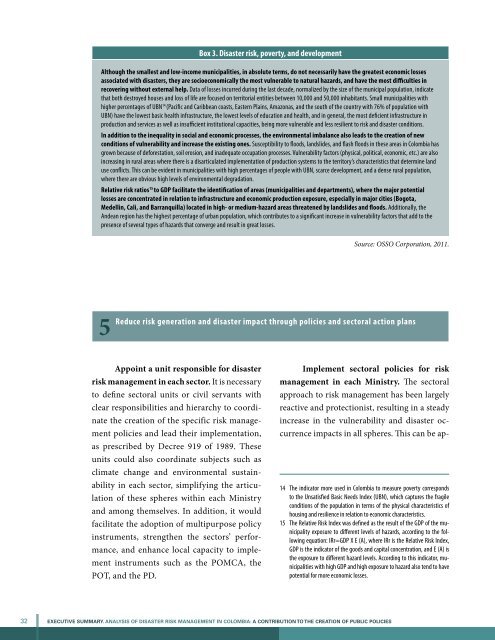Executive Summary - GFDRR
Executive Summary - GFDRR
Executive Summary - GFDRR
You also want an ePaper? Increase the reach of your titles
YUMPU automatically turns print PDFs into web optimized ePapers that Google loves.
Box 3. Disaster risk, poverty, and development<br />
Although the smallest and low-income municipalities, in absolute terms, do not necessarily have the greatest economic losses<br />
associated with disasters, they are socioeconomically the most vulnerable to natural hazards, and have the most difficulties in<br />
recovering without external help. Data of losses incurred during the last decade, normalized by the size of the municipal population, indicate<br />
that both destroyed houses and loss of life are focused on territorial entities between 10,000 and 50,000 inhabitants. Small municipalities with<br />
higher percentages of UBN 14 (Pacific and Caribbean coasts, Eastern Plains, Amazonas, and the south of the country with 76% of population with<br />
UBN) have the lowest basic health infrastructure, the lowest levels of education and health, and in general, the most deficient infrastructure in<br />
production and services as well as insufficient institutional capacities, being more vulnerable and less resilient to risk and disaster conditions.<br />
In addition to the inequality in social and economic processes, the environmental imbalance also leads to the creation of new<br />
conditions of vulnerability and increase the existing ones. Susceptibility to floods, landslides, and flash floods in these areas in Colombia has<br />
grown because of deforestation, soil erosion, and inadequate occupation processes. Vulnerability factors (physical, political, economic, etc.) are also<br />
increasing in rural areas where there is a disarticulated implementation of production systems to the territory’s characteristics that determine land<br />
use conflicts. This can be evident in municipalities with high percentages of people with UBN, scarce development, and a dense rural population,<br />
where there are obvious high levels of environmental degradation.<br />
Relative risk ratios 15 to GDP facilitate the identification of areas (municipalities and departments), where the major potential<br />
losses are concentrated in relation to infrastructure and economic production exposure, especially in major cities (Bogota,<br />
Medellin, Cali, and Barranquilla) located in high- or medium-hazard areas threatened by landslides and floods. Additionally, the<br />
Andean region has the highest percentage of urban population, which contributes to a significant increase in vulnerability factors that add to the<br />
presence of several types of hazards that converge and result in great losses.<br />
Source: OSSO Corporation, 2011.<br />
5<br />
Reduce risk generation and disaster impact through policies and sectoral action plans<br />
Appoint a unit responsible for disaster<br />
risk management in each sector. It is necessary<br />
to define sectoral units or civil servants with<br />
clear responsibilities and hierarchy to coordinate<br />
the creation of the specific risk management<br />
policies and lead their implementation,<br />
as prescribed by Decree 919 of 1989. These<br />
units could also coordinate subjects such as<br />
climate change and environmental sustainability<br />
in each sector, simplifying the articulation<br />
of these spheres within each Ministry<br />
and among themselves. In addition, it would<br />
facilitate the adoption of multipurpose policy<br />
instruments, strengthen the sectors’ performance,<br />
and enhance local capacity to implement<br />
instruments such as the POMCA, the<br />
POT, and the PD.<br />
Implement sectoral policies for risk<br />
management in each Ministry. The sectoral<br />
approach to risk management has been largely<br />
reactive and protectionist, resulting in a steady<br />
increase in the vulnerability and disaster occurrence<br />
impacts in all spheres. This can be ap-<br />
14 The indicator more used in Colombia to measure poverty corresponds<br />
to the Unsatisfied Basic Needs Index (UBN), which captures the fragile<br />
conditions of the population in terms of the physical characteristics of<br />
housing and resilience in relation to economic characteristics.<br />
15 The Relative Risk Index was defined as the result of the GDP of the municipality<br />
exposure to different levels of hazards, according to the following<br />
equation: IRr=GDP X E (A), where IRr is the Relative Risk Index,<br />
GDP is the indicator of the goods and capital concentration, and E (A) is<br />
the exposure to different hazard levels. According to this indicator, municipalities<br />
with high GDP and high exposure to hazard also tend to have<br />
potential for more economic losses.<br />
32 EXECUTIVE SUMMARY. ANALYSIS OF DISASTER RISK MANAGEMENT IN COLOMBIA: A contribution TO the creation of public policies

















